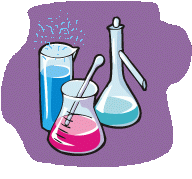


Description of experiment
Below follows a plain text transcript of the selected experiment.
![]()
Needed compounds:
-----------------
sodium sulfite : Na2SO3
hydrochloric acid : HCl
potassium bromate : KBrO3
Class:
------
elem=Br,Cl
redox
Summary:
--------
Potassium bromate reacts vigorously with concentrated hydrochloric acid.
A green gas is evolved, but this gas has a color, which is fairly intense.
The green gas consists of chlorine, but it also contains bromine, probably
combined with chlorine in a compound as BrCl, which is slightly darker
green than Cl2.
Description:
------------
Add a small amount of concentrated hydrochloric acid (appr. 30% by weight)
to some KBrO3: Strong bubbling, a green gas (mixture) is evolved. The gas
mixture has a fairly intense color, much more intense than one would expect
when chlorine is formed. The smell of the gas, however, non-mistakenly is
the smell of chlorine.
Cap the test tube loosely, allowing release of gas, but assuring that not
much air is coming in and let the KBrO3 dissolve, while it is bubbling. In
this way a fairly pure gas mixture is collected.
Bubble the gas mixture into a little bottle, which is completely filled
with water and quickly cap the bottle. Approximately 30% of the volume of
the bottle is filled with the green gas, the rest is filled with water.
Shake well: The green gas dissolves almost completely in the water. When the
cap is opened, a hissing noise is heard, due to air flowing into the bottle.
The water has become green.
Dissolve some sodium sulfite in dilute HCl (appr. 10%) and add this solution
to the green liquid in small amounts and shake well all the time: The liquid
remains green after the first few batches of small amounts of sulfite, but
after three batches it suddenly becomes yellow. A distinct color change
can be observed. When another batch of sulfite is added, the liquid becomes
colorless. As long as the liquid was green, a choking smell of chlorine was
released from the liquid, when the liquid was yellow, it was odourless and
the colorless liquid also is odourless.
Explanation: The green compound probably is BrCl. This compound has a much
stronger color than chlorine and hence, after the first two batches, when
chlorine is reduced first, no noticeable change of color occurs. After the
third batch, the chlorine was reduced and reduction continues with break-
down of BrCl. When BrCl is in excess amount, then free bromine is released
and the chlorine part is reduced to chloride. Finally, when an excess amount
of sulfite is added, the bromine is reduced as well and the liquid becomes
colorless.
![]()